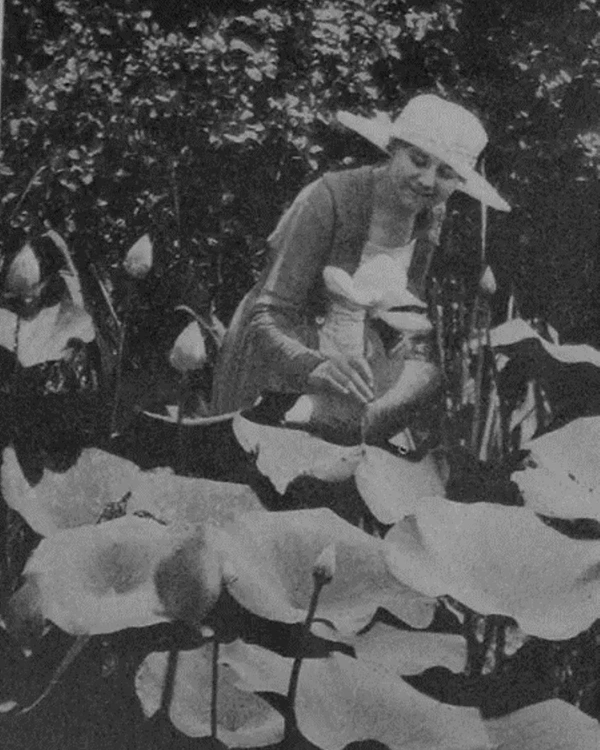Last updated: December 6, 2023
Person
Helen Fowler

NPS
Helen Fowler was a talented businesswoman and horticulturalist. After taking over her father’s business, Helen Fowler expanded the aquatic garden’s influence and traveled the world to find new plants to add to the beauty of the gardens. Helen Fowler transformed Kenilworth Aquatic Gardens into what it is today.
Birth and Childhood
Lucy Helen Shaw was born in 1875. She lived with her parents and two brothers in downtown Washington DC while her father worked for the US Treasury. She went by her middle name, Helen. In 1879 the family bought 33 acres of land along the Anacostia River and Helen’s life changed forever. As a child she wandered the open spaces and immersed herself in nature. She helped her dad with his burgeoning aquatic garden business by learning all about the propagation of aquatic plants and business bookkeeping during her teen years.
Family and Early Career
Helen Married James M. Fowler, a local draftsman, on July 8, 1891. They lived in an old tenant house next to the gardens. She and James lost their only child, Marian, to disease in 1910. Helen continued to help her father with the business. In 1912 Walter Shaw purchased a truck that he called a “gas wagon” for the gardens to transport and sell flowers. Helen was the driver of the truck and became the first woman in Washington DC to hold a commercial drivers’ license.
James died sometime before 1920 and Walter Shaw died in 1921. Helen’s brother, Charles, helped her through this time and they became co-owners of the gardens upon their father's death.
Expanding the Gardens
Helen was an astute businesswoman, selling 3,000-5,000 lilies daily along with 3,000 other aquatic plants a week. The site welcomed as many as 6,000 visitors a day during the summer and generated profits of almost $61,000. In the 1930s the gardens were expanded to 42 ponds and 500,000 plants. Around 1930 at 55 years old, Helen began painting water lilies. She enjoyed this newfound hobby, and her paintings accompanied the garden catalog in the 1930s so customers could see what they were purchasing when the flowers were not in bloom.
Helen constantly worked to expand and diversify the collection of aquatic plants at the gardens. In 1913, the Shaws built two steam-heated greenhouses to keep tropical plants alive in the winter months. By 1931 Helen sold 55 different varieties of water lilies.
Not only a place of business, the gardens were also a popular spot for rest and reflection. Washingtonians would come to the gardens in the early mornings for a picnic breakfast. They would enjoy the cooler temperatures and walk the gardens before the lilies close in the hot afternoon sun. President and Mrs. Woodrow Wilson, Mrs. Warren Harding and Mrs. Calvin Coolidge, were all frequent visitors and Helen considered them all friends.
Helen travelled the world to collect lilies and other aquatic plants. Gilbert Haugen of the House of Representatives Committee on Agriculture and Frederick Coville, botanist and curator of the US National Herbarium, wrote introductory letters about her. These letters helped her gain acceptance across the globe. She was a frequent speaker on aquatic gardens throughout the District of Columbia. She served as a judge for many flower exhibitions and served on the American Horticultural Society exhibition committee. Like her father, Helen cultivated different varieties of lilies, including the pink ‘Rose Arey,’ named for her cousin and a night blooming lily named the “Kenilworth Comet.’
“I love them as I would my own children” Helen told the Washington Times April 8, 1937
Conflict with the Government
Despite the success of the business, the garden’s future became uncertain when the US Government wanted to expand Anacostia Park to give the public access along the river. The government wanted to use eminent domain to take over the Shaw Gardens. In 1929 Helen and her brother Charles filed a lawsuit with the government over control of the gardens. This action delayed the purchase of the land. However in 1933 Congress authorized a plan to fill in the marsh and swamp areas along the Anacostia River in the name of controlling malaria-bearing mosquitoes. Helen fought the takeover of the gardens valiantly for several years, but with government and political pressure weighing against her, she finally agreed to sell the gardens in 1938 for $50,000. The government agreed not to fill in the marsh and to keep the aquatic ponds. The National Park Service took control of the land, but Helen was able to rent her house from the government and she lived on the property until her death. She helped train park service personnel on how to grow and maintain the gardens and gave occasional tours of the ponds.
In 1957 Helen died away at 82 years old. Her home was demolished soon after, yet her legacy lives on in the beautiful park.
